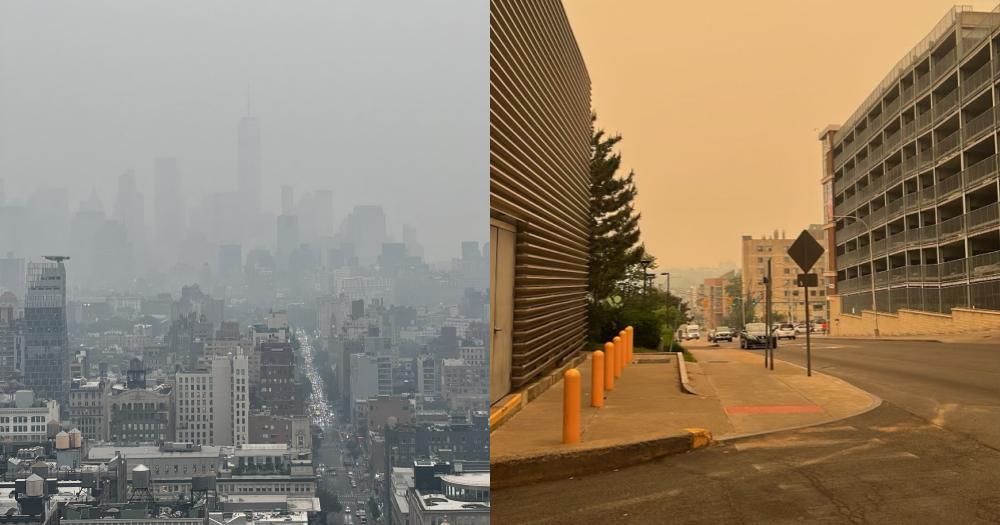Follow us on Telegram for the latest updates: https://t.me/mothershipsg
A thick layer of haze has blanketed New York City's skyline as harmful smoke drifted from a hundred miles to the north, where hundreds of wildfires are burning in Quebec, Canada, CNN reported.
Heavy smoke from Canadian wildfires shrouds midtown Manhattan at sunset in New York City seen from the 86th floor of the Empire State Building, Tuesday evening #newyorkcity #nyc #newyork @empirestatebldg #smoke @agreatbigcity pic.twitter.com/g2jkP3nVYK
— Gary Hershorn (@GaryHershorn) June 7, 2023
Worst air pollution
The haze made New York City among the top five cities with the worst air pollution in the world alongside Dhaka, Bangladesh, Jakarta, Indonesia, and New Delhi, India, as of Tuesday afternoon (Jun. 6).
This has caused at least 10 school districts in central New York to cancel outdoor activities and events such as outdoor recess and extracurricular activities.
NO FILTER on this picture! A friend from back home in upstate New York sent me this picture. Air quality alert ‼️ in place due to smokey haze from the Canadian wild fires. pic.twitter.com/n7iwzYyIFE
— Don Shipman (@DonShipman) June 6, 2023
There are 154 cases of wildfires in Quebec at the time of writing, according to a live update by Canadian Interagency Forest Fire Centre.
Meanwhile, there are currently 424 cases of active fires across Canada, with 248 cases being categorised as out of control.
Almost 9 million acres of land have been affected by the wildfires in Canada this year, with nearly half a million burned across Quebec.
New York State officials have issued an air quality health advisory for several regions in New York including Long Island, New York City Metro, and Central New York regions. The advisory took effect on Jun. 6 before it was extended to Jun. 7.
Exposure may increase health issues
Officials identified the pollutant of concern as fine particular matter of PM2.5.
The New York State Department of Health defines PM2.5 as tiny particles or droplets in the air that are two and one-half microns or less in width.
PM2.5 can be made of many different types of particles and is often derived from processes that involve combustion and chemical reactions in the atmosphere such as the burning of fuels, vehicle exhausts, and forest and grass fires.
PM2.5 will reduce visibility and cause air to appear hazy when its levels are high.
New York City skyline at 7:43 PM under the haze of the Canada wildfires. This is facing downtown, if you zoom in you can just hardly make out One World Trade pic.twitter.com/kKuTKE3BYK
— Emily (@emilybernay) June 6, 2023
Exposure to PM2.5 can cause short-term health effects such as eye, nose, throat, and lung irritation, coughing, sneezing, runny nose and shortness of breath.
Exposure may also affect lung function and make medical conditions such as asthma and heart disease worsen.
Meanwhile, long-term exposure may increase the rates of chronic bronchitis, reduced lung function, and death from lung cancer and heart disease.
People with heart or breathing problems, children, and the elderly may be more vulnerable to PM2.5.
What caused the haze issues?
At first glance, the haze issues can be attributed to natural causes, though CNN reported that human-attributed climate change has worsened hot and dry conditions that allowed wildfires to grow.
Recent reports by scientists found that millions of wildfires in the Western U.S. and Canada could be traced back to carbon pollution from the world's largest fossil fuel and cement companies.
Singapore faced similar issues when forest fires in the Indonesian islands of Sumatra and Kalimantan caused haze outbreaks.
One of the most serious haze outbreaks affecting Singapore took place in 2013. It saw the highest PSI reading of 401 being recorded on Jun. 21 2013.
The cause of the 2013 haze outbreak was massive land burning carried out by palm oil companies.
Recently, the Indonesian Coordinating Minister for Maritime and Investment Affairs Luhut Binsar Pandjaitan said that the country is prepared to tackle haze problems through climate modification technology.
Read more:
Top image via @emilybernay and @DonShipman/Twitter.
If you like what you read, follow us on Facebook, Instagram, Twitter and Telegram to get the latest updates.

